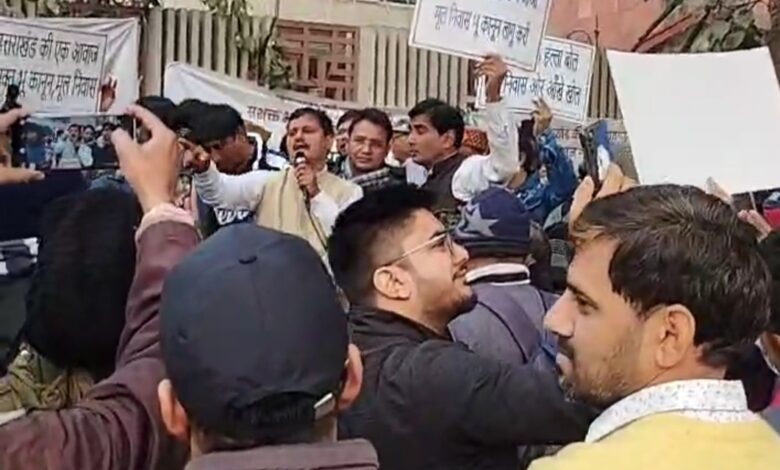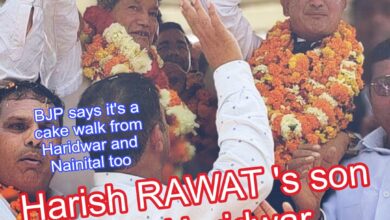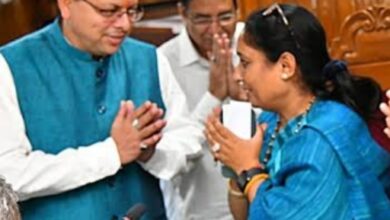After a massive rally at Dehradun to demand a Concrete Land Act and 1950 as base year for residential proof protest demonstration held in Delhi in front of UK Resident Commissioner


Several socio political organisations of Uttarakhand in Delhi, activists of Uttarakhand Kranti Dal, Garhwal Hiteshini Sabha, Uttarakhand Journalists Forum, Uttarakhand Lok Manch and Samyukt Sangharsh Samittee including journalists, writers and thinkers of Uttarakhand in the national capital today protested in large numbers despite chilling cold weather and literally no sun since the last three days with full dedication raising slogans demanding a Concrete Land Act of Uttarakhand, 1950 as the base year for residential proof in Uttarakhand, implementation of article 371 as in several North Eastern States and abolition of the existing law that has lifted the ceiling of 12.5 acres of land enabling more than forty percent of the agricultural and other lands having behind sold n bought by the outsiders under the guise of opening of certain industries etc.

People from different locations of Delhi and NCR participated in this protest demonstration which was held outside the office of the resident commissioner of Uttarakhand at Rouse Avenue near ITO, New Delhi. A memorandum was also presented to the resident commissioner addressed to chief minister of Uttarakhand on this occasion.
Kindly recall that just few days ago a massive rally on these same demands was organised in Dehradun in which thousands of ex servicemen, students, youths, women and even senior citizens from various nooks and corners of the country participated and marched several kilometres holding play cards in their hands and raising anti BJP government slogans demanding concrete land act and the 1950 being the base year to grant residential certificate to Uttarakhand’s inhabitants.
In Delhi Charu Tiwari , a credible think tank of Uttarakhand and several known faces usually seen in cultural events and social actions were present on this ocassion.
What is important to note about this demand is that despite the chilling cold weather the people were in large numbers in full enthusiasm and with energy raising slogans carrying play cards in support of the above demands.

Dissatisfaction regarding ‘original residence’ has been growing in Uttarakhand for the last several years. After Covid, when people started going back to their villages, for the first time after the formation of the state, they realized that their rights were being snatched away. He started trying to know them afresh. ‘Original Residence’ is a constitutional provision given to every state in the Indian Constitution, which gives the right to be a native citizen of that state. With this right, he is the first entitled to all those facilities and opportunities which the governments provide to the people there from time to time.

But, instead of increasing these facilities in Uttarakhand, the elected governments from the first interim government till today worked to abolish them. The demand of this movement is that the limit of original residence of 1950 should be implemented in Uttarakhand.
This demand of the people of Uttarakhand is not unexpected. With the implementation of the Constitution in our country in 1950, a provision was made that the person who was living in the state in the year of implementation of the Constitution i.e. 1950, would be considered a native of that state. The country’s presidential notification was issued for this.

This provision was again notified by the President in 1961 because more states were formed in the sixties. On the basis of this notification, reservation and other schemes were started whose benefits could be availed by the original residents of that state. It is currently applicable in every state across the country.
After the formation of the state, when the first interim government was formed under the leadership of Nityananda Swami, it refused to consider the residents here as ‘original inhabitants’. This government considered ‘original resident’ and ‘permanent resident’ as one and the same and fixed its cut off date as 1985. After this, the system of ‘permanent residence’ instead of ‘original residence’ came into force in the state. Due to this, the rights of the residents here were attacked. Due to the cut off date being 1985, a large number of people who were living in the state 15 years ago also became entitled to local rights.
After the formation of the state in Uttarakhand, the demand for changing the original residence to 1950 was continuously raised. A good sign in this matter was received in 2010 when, on a petition related to native residence, the Supreme Court of India and the High Court of Uttarakhand upheld the Presidential Notification of 1950 in Uttarakhand also, while continuing the system of single domicile i.e. native residence in the country.

At that time, ‘Naina Saini vs. State of Uttarakhand’ in the Uttarakhand High Court and ‘Pradeep Jain vs. Government of India’ in the Supreme Court said in two separate petitions that the person residing here at the time of formation of Uttarakhand state should be considered as the original resident, but Both the courts did not accept this and kept the provision of 1950 in force.
This decision was a great relief for the citizens of Uttarakhand, but in 2012, while hearing a PIL related to the same matter, a single bench of the Uttarakhand High Court ruled that whoever was a citizen of Uttarakhand on November 9, 2000, i.e. the day of formation of the state, Anyone living within the border will be considered a native of this place. The then Congress government accepted that decision. She neither went to the High Court nor approached the court against this decision of the single bench.
However, the state government had planned to put an end to this issue since 2010 in the light of the decisions given by the Supreme Court and the High Court. Later in 2012, a petition was filed to challenge the decision of the single bench to fix the cut off date for state formation i.e. 2000, but the then government did not do so.
This challenge was also necessary because the decision was in violation of Section 24 and 25 of ‘Uttarakhand State Reorganization Act-2000’ along with Act-5 and 6 Schedule of the Presidential Notification. But the government did not do this and the system of permanent residence was fully implemented in the state.
Due to its implementation, the rights of the residents here on local resources and the concessions given by the governments from time to time have been limited, because after the cut off date of 1985, a large number of them also became entitled to get the rights from the permanent residents. Who are living in Uttarakhand since 1985 or 2000. For a state with limited opportunities like Uttarakhand, which is already facing the brunt of migration, this has become associated with the question of saving its existence.
Similarly, in the context of the Concrete Land Act of Uttarakhand the most worrying matter for Uttarakhand is that due to the anti-people land laws of the governments, the area of cultivable land in the state has been continuously decreasing. At present only 4 percent of the land in the state is being cultivated. We have maximum 6 percent cultivable land left. Of the total land area in the state, 63 percent is forest, 14 percent is agriculture, 18 percent is wasteland and 5 percent is waste or unfit land. The British had measured our lands 11 times. After independence, partial measurement was finally done in 1964. People have been separated from their land due to the expansion of Rashtriya Parks and Van Vihars. Therefore, our first demand is that by measuring the lands in Uttarakhand, the lands which were wrongly deposited in the forest department and government accounts should be freed and included in the agricultural land.
Despite these shocking figures, governments made arrangements to sell our lands outright. The Trivendra Rawat-led BJP government had introduced the ‘Uttar Pradesh Zamindari Abolition and Land System Act 1950 (Adaptation and Modification Order 2001) (Amendment) Ordinance-2018’ in the Assembly on December 6, 2018. This ordinance, in the form of a new land law, opened the way for rampant plunder of land in the hills.
Not only this, the provision of Section 143 of the Act was also abolished in the new amendment. Earlier, according to this Act, permission from the Revenue Department was required to convert agricultural land into other use. Through this amendment this section was changed to 143 (A). Now we have to get the proposal for our industry passed by the government. There is no need to change the land use of the agricultural land purchased for this. It will very easily be considered as non-cultivable land.
The biggest feature of this amendment is that it gives freedom to any investor to buy land for setting up an industry in the hills. Going beyond this, the government has amended Section 156 of this law and passed an ordinance to give land on lease for thirty years. From this it can be understood how hollow are the claims of the governments talking about providing employment through agriculture. Therefore, we demand that the amendments made by the government in the land law in 2018 should be immediately repealed.
Understanding the sensitivity of other Himalayan regions of the country except Uttarakhand, very strict land laws have been made here. In Jammu and Kashmir, there was a ban on buying and selling of land due to Articles 370 and 35-A of the Constitution (now removed). In the North-Eastern states, lands have been saved through Section 371. In our neighboring state Himachal Pradesh, there is Section 118 in ‘Control on Transfer of Land’ in Chapter 11 of ‘Himachal Pradesh Tennessee and Land Reforms Act-1972’.
According to this section, land cannot be transferred to any non-farmer in Himachal. This also means that even a non-farmer, a resident of Himachal, cannot purchase any agricultural land. Section 3 of 38-A of the same section also says that any Indian (non-Himachali) can apply to purchase residential land. Its limit will also be 500 square meters. But for this also permission will have to be taken from the government. If non-Himachal government employees also want to build their residence, they should also have a certificate of thirty years of government service in Himachal.
In Section 3(a) of Sikkim’s ‘The Sikkim Regulation of Transfer of Land (Amendment) Act-2018, it has been provisioned that land can be bought or sold only in the Limbu or Tamang community. This provision has also been made that the seller of land will have to keep at least three acres of land with himself. This provision was made so that the person selling the land does not remain landless.
From these brief data and existing laws, we can understand how there have been conspiracies to separate the people of Uttarakhand from their land. If it is not countered in time, then we are going to face a crisis of survival. The echo of protest that has emerged from the youth across Uttarakhand regarding all these concerns in the past few days is bound to have an impact on the migrants, who suffer the most from the tragedy of migration.







A concrete land act should be implemented in Uttarakhand spl.- 1950.’